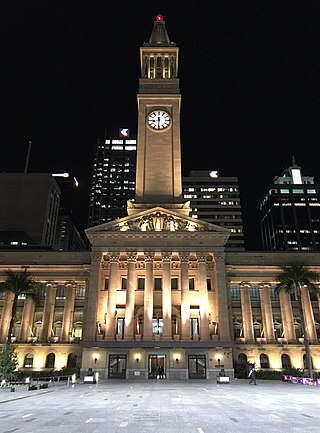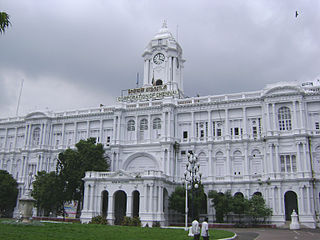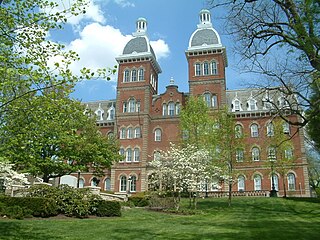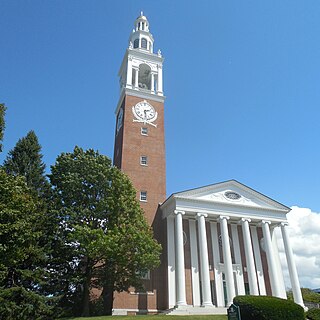
Sather Tower is a bell tower with clocks on its four faces on the campus of the University of California, Berkeley. It is more commonly known as The Campanile for its resemblance to the Campanile di San Marco in Venice. It is a recognizable symbol of the university.

The University of Arkansas is a public land-grant research university in Fayetteville, Arkansas. It is the flagship campus of the University of Arkansas System. Founded as Arkansas Industrial University in 1871, classes were first held in 1872, with its present name adopted in 1899.

Brisbane City Hall, in Brisbane, Queensland, Australia, is the seat of the Brisbane City Council. It is located adjacent to King George Square, where the rectangular City Hall has its main entrance. The City Hall also has frontages and entrances in both Ann Street and Adelaide Street. The building design is based on a combination of the Roman Pantheon, and St Mark's Campanile in Venice and is considered one of Brisbane's finest buildings. It was listed on the Register of the National Estate in 1978 and on the Queensland Heritage Register in 1992. It is also iconic for its Westminster chimes which sound on the quarter-hour.
There are many buildings on the campus of the University of Arkansas. Most of the historic structures are part of the University of Arkansas Campus Historic District on the National Register of Historic Places. This article focuses on the non-listed buildings.

Tom Tower is a bell tower in Oxford, England, named after its bell, Great Tom. It is over Tom Gate, on St Aldates, the main entrance of Christ Church, Oxford, which leads into Tom Quad. This square tower with an octagonal lantern and facetted ogee dome was designed by Christopher Wren and built 1681–82. The strength of Oxford architectural tradition and Christ Church's connection to its founder, Henry VIII, motivated the decision to complete the gatehouse structure, left unfinished by Cardinal Wolsey at the date of his fall from power in 1529, and which had remained roofless since. Wren made a case for working in a Late Gothic style—that it "ought to be Gothick to agree with the Founders worke"—a style that had not been seen in a prominent building for a hundred and fifty years, making Tom Tower a lonely precursor of the Gothic Revival that got underway in the mid-18th century. Wren never came to supervise the structure as it was being erected by the stonemason he had recommended, Christopher Kempster of Burford.

University, Hayes and Orton Halls are three historic buildings on the Oval at the Ohio State University in Columbus, Ohio. On July 16, 1970, they were added to the National Register of Historic Places. The original University Hall was demolished in 1971, and removed from the National Register that year.

The Ripon Building is the seat and headquarters of the Greater Chennai Corporation in Chennai, Tamil Nadu. It is an example of neoclassical architecture, a combination of Ionic and Corinthian styles. The Ripon Building is an all-white structure and is located near the Chennai Central railway station.

Jesse Hall, formerly New Academic Hall, is the main administration building for the University of Missouri. Its dome has towered 180 feet (55 m) above the south end of David R. Francis Quadrangle since its completion in 1895. In the lawn in front of Jesse Hall are The Columns, all that remains of its predecessor Academic Hall, which was destroyed by fire in 1892. The building contains the office of the chancellor, university registrar, graduate school, admissions, and financial aid. One of the most photographic landmarks in Missouri, the building was designed by Missouri architect Morris Frederick Bell, and is his largest surviving work. Jesse Auditorium had hosted graduations and many university functions over the years. The University Concert Series presents national and international concerts, Broadway shows, performers, bands, speakers, and theater to the largest auditorium in Columbia. As the former home of the School of Music, student performances occasionally take place. The building is the most prominent contributing structure to the David R. Francis Quadrangle National Register of Historic Places District. In 1922, "New Academic Hall" was renamed "Jesse Hall" in honor of retiring University President Richard Henry Jesse.

Crouse College, also known as Crouse Memorial College and historically as John Crouse Memorial College for Women, is a building on the Syracuse University campus. It was funded by John R. Crouse, a wealthy Syracuse merchant with the White family, and designed by Archimedes Russell. It is built in the Romanesque revival—Richardsonian Romanesque style.
This is an incomplete list of historic properties and districts at United States colleges and universities that are listed on the National Register of Historic Places (NRHP). This includes National Historic Landmarks (NHLs) and other National Register of Historic Places listings. It includes listings at current and former educational institutions.

The Wayne State University historic district consists of three buildings on 4735-4841 Cass Avenue in Midtown Detroit, Michigan: the Mackenzie House, Hilberry Theatre, and Old Main, all on the campus of Wayne State University. The buildings were designated a Michigan State Historic Site in 1957 and listed on the National Register of Historic Places in 1978.

The History of the University of Arkansas began with its establishment in Fayetteville, Arkansas, in 1871 under the Morrill Act, as the Arkansas Industrial College. Over the period of its nearly 140-year history, the school has grown from two small buildings on a hilltop to a university with diverse colleges and prominent graduate programs. Its presidents have included Civil War general Daniel Harvey Hill, John C. Futrall, and J. William Fulbright.

Old Main is the main academic building at Washington & Jefferson College. It is the predominant building on campus and has served virtually every student since its construction. Its two identical towers, added in 1875, symbolize the union of Washington College and Jefferson College to form Washington & Jefferson College. The towers appear on the college seal, in a stylized version. The college fundraising operation founded "The Old Main Society" in 1996 to recognize individuals who utilize planned giving.
The University of Arkansas Campus Historic District is a historic district that was listed on the National Register of Historic Places on September 23, 2009. The district covers the historic core of the University of Arkansas campus, including 25 buildings.

The Washington County Courthouse is the name of a current courthouse and that of a historic one in Fayetteville, Arkansas, the county seat of Washington County. The historic building, built in 1905, was listed on the National Register of Historic Places in 1972. The historic courthouse is the fifth building to serve Washington County, with the prior buildings located on the Historic Square where the Old Post Office is today. The building is one of the prominent historic buildings that compose the Fayetteville skyline, in addition to Old Main.

The Chi Omega Chapter House is a building built in 1927 on the campus of the University of Arkansas in Fayetteville, Arkansas. The building was listed on the National Register of Historic Places in 1995. The house is located at 940 West Maple in Fayetteville.

Tillman Hall is the most famous building on the Clemson University campus. The 3-story brick building with a clock tower is located on a hill overlooking Bowman Field. Tillman Hall is currently the home of the College of Education.

Ira Allen Chapel is a building on the campus of the University of Vermont (UVM), which is located on the northeast corner of the "University Green" in Burlington, Vermont. The building was constructed during 1925–26, and dedicated on January 14, 1927. It was added to National Register of Historic Places as part of University Green Historic District on April 14, 1975.

The Ōkuma Auditorium, officially the Waseda University Ōkuma Memorial Hall, is a Tudor Gothic auditorium of Waseda University in Totsuka, Shinjuku, Tokyo. Designed primarily by Kōichi Satō, construction of the auditorium was planned to begin in 1923 following the death of Waseda founder Ōkuma Shigenobu. Its construction was halted by the 1923 Great Kantō earthquake but eventually began in 1926. It opened in 1927, commemorating the 45th anniversary of the founding of Waseda University. The auditorium includes a large hall with a capacity of over 1,100 seats and a basement hall of about 300 seats. The university's activities, lectures and concerts are held in the auditorium. The clock tower chimes six times a day.

University College, historically known as the Arts Building, is an academic building of the University of Western Ontario on its main campus in London, Ontario. The building has become an iconic symbol of the university, as well as a prominent landmark in the city of London. The building sits atop a hill and faces the Thames River. Along with the Physics and Astronomy Building, University College is one of the first buildings that was built on the present campus in 1922. The building currently houses the Faculty of Arts and Humanities.






















